What is Turbocharger Surging?
Turbocharger is one of the most important parts of the main propulsion system of the ship. Turbocharger surging is a phenomenon, which affects the performance of the turbocharger and reduces its efficiency. In this article, we will learn everything about turbocharger surging.
What is Turbocharger Surging?
Turbocharger surging may be defined as a high pitch vibration of audible level coming from the blower end or compressor end of the turbocharger.
It is frequently experienced in low-speed diesel engines, and a sea-going marine engineer must have heard this howling sound generated from the engine at least once in his/her sea career.
Related Read: 8 Common Problems Found In Ship’s 2-Stroke Marine Engines
Whenever the breakdown of gas flow takes place in the turbocharger, a reversal of scavenging air occurs through diffuser and impeller blades into the blower side which causes surging.
In simple words, a big mass of oscillating airflow can cause vibration of the turbo compressor impeller and its vanes, which make the compressor unable to operate normally, producing a high pitch noise as a reaction, which is known as compressor surge.
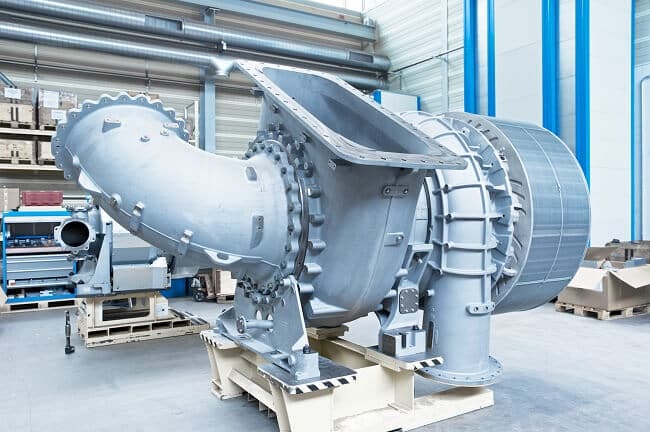
Other terminologies such as turbo surge or engine surge may also be used to describe this phenomenon, but the directly involved component is surging is the compressor of the turbocharger or the turbo-compressor.
The turbine side or exhaust gas side of the turbocharger does not play a direct role in the surging process. It may undoubtedly affect the performance of the complete turbocharger, which may lead to the turbocharger surging.
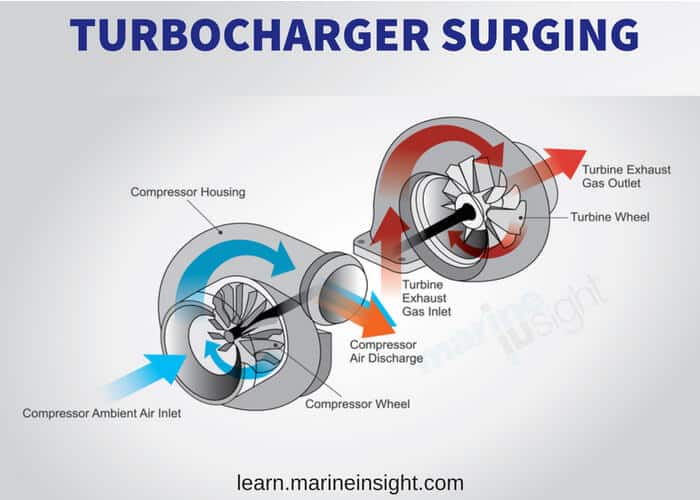
During engine operation at sea, few events of surging may occur as it also depends on external factors such as sea state, weather, abrupt manoeuvring, crash stop, etc. Such cases of compressor surge are acceptable.
However, the engineer on the ship must ensure that the condition of the turbocharger bearing and the lube oil is in good service condition.
Related Read: Understanding Turbocharger Bearings and Lubrication On Ships
If the surging happens during normal engine operation and the frequency of engine surge is high, it may lead to damage to the bearing and in some cases, results in mechanical failure of the compressor rotor. Hence, the turbocharger surging is a result of various engine parts not performing in sync.
A worn-out engine cylinder or fuel system may lead to problems in the engine and the turbocharger. This will result in less airflow to the compressor against the higher back pressure, making the compressor surge.
Therefore, turbochargers must be matched properly with the engine air consumption rate and pressure across the operating range of the engine and should not fall into the surge limits.
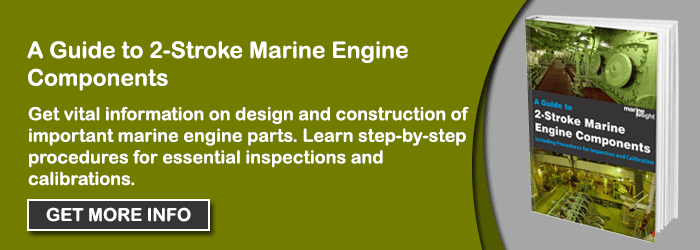
The Surge Line
As shown in the graph, the operating line of the engine should maintain the pressure and volume of the intake air at point A to maintain the equilibrium and efficient working of the turbocharger. Suppose, there is an increase in the intake air volume, the pressure will decrease on the line of constant speed. To maintain the equilibrium, i.e. to be on the operating line, the volume has to decline.
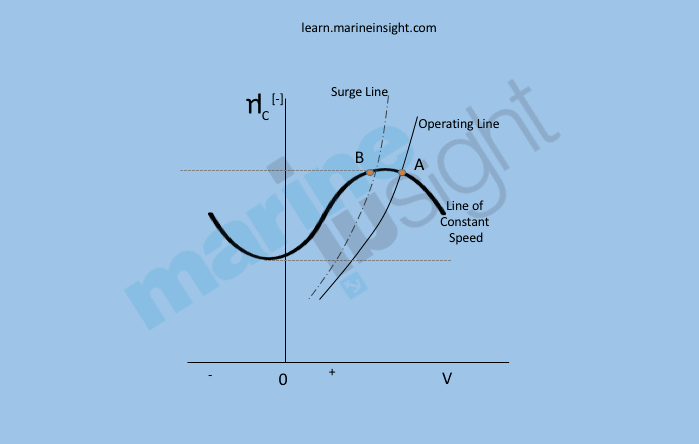
However, if there is a slight decrease in volume at point B (at the same pressure as A), it will result in the reduction of pressure on constant speed line. At this stage, the compressor will not be able to maintain the required pressure and the volume will further decrease leading to compressor surge.
Terms Associated with Turbocharger Surge:
Surge pressure dip: The surge cycle has a specific pressure dip and if the cycle continues without changing the operating point, the size of the pressure dip will sustain.
Surge cycle time: The time at which the surge starts until the operating point is changed to reach the equilibrium again, i.e. the end of engine surge.
Surge temperature behaviour: As the surge happens, there will be a reversal of airflow, leading to a change in the temperature of the upstream.
Surge shaft speed variations: The shaft of the turbocharger containing compressor and turbine wheel will also experience a change in speed during the compressor surge
The turbochargers should therefore appropriately match with the engine air consumption rate and pressure across the operating range of the engine, and should not fall into the surge limits.
Category of Turbocharger Surging:
Mild surge: The surges happening under mild conditions are not significant. They may arise due to no flow reversal and small oscillations in pressure.
Classic surge: Classic surge which happens due to low-frequency oscillations with larger pressure oscillations.
Deep surge: This is the critical condition when the reversal of the mass flow occurs in the compressor which leads to surging.
What are the Causes of Turbocharger Surging?
The following are the causes of turbocharger surging:
Improper power distribution: Inadequate power distribution between the main engine cylinders may cause turbocharger surging as one unit is producing more power and the other is producing less. Due to this the air consumption required by both the turbochargers differs, which leads to surging.
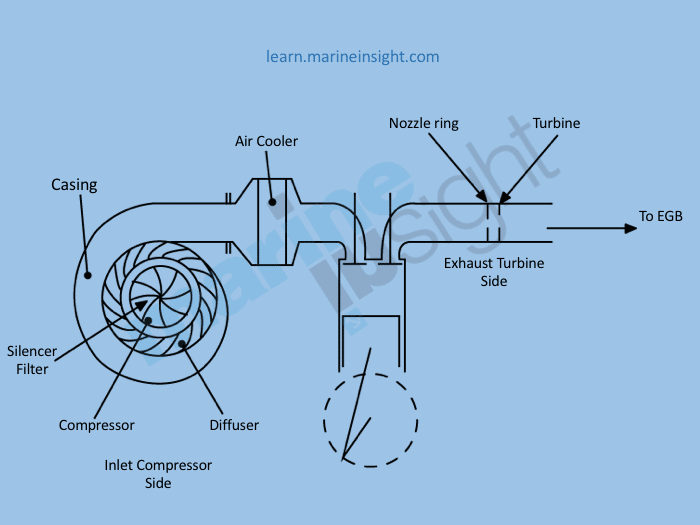
Fouled turbocharger parts:
- If the inlet filter for the compressor on the turbine side is dirty, then enough air cannot be supplied for combustion, which leads to surging.
- Similarly, if the turbine side is also dirty i. e nozzle, blades etc. enough air cannot be produced for combustion
- Damaged silencer
- Worn out turbocharger bearings
Related Read: How To Clean Blower and Turbine Sides of a Turbocharger on Ship?
Problems in the Scavenge Air System:
- Fouled air cooler and water mist catcher
- No water circulation inside the cooler
- Fouled cooling tubes
- Carbon deposits in scavenge ports
- High receiver temperature
Related Read: How Marine Air Charging System For Engines Has Changed Over Time
Problems in the Exhaust System: Highly fouled exhaust i.e. economizer, if fitted, may cause back pressure in the turbocharger and thus finally lead to surging. Other exhaust problem may be as follows:
- Exhaust valve malfunctioning and not opening properly
- Damaged or blocked protective grating before the turbocharger
- Pressure pulsations after turbocharger and inside the exhaust receiver
- Damaged compensator fitted on the line of turbocharger entry
Related Read: Components and Design of Exhaust Gas System of Main Engine On Ship
Problem In the Fuel System: If the fuel system is not operating efficiently, it can be due to the following problems:
- Low circulating or supply pump pressure
- Air or water in the fuel oil
- Low preheating temperature of the fuel
- Defective fuel pump suction valve
- Sticking fuel pump plunger and valve spindle due to carbon deposits
- Damaged fuel valve nozzle
- Faulty load distribution system
Related Read: 10 Points for Efficient Turbocharger Operation On Ships
Other Factors:
- Due to bad weather, the engine suddenly starts racing, and sudden load change takes place. This happens because, during bad weather or pitching, the propeller moves in and out of the water, causing the change in load on the engine
- Badly matched engine and turbocharger tuning, which may occur in the old engine due to the isolation of one or more unit or a faulty engine part
- Change in the ambient condition, i.e. pressure and temperature variation
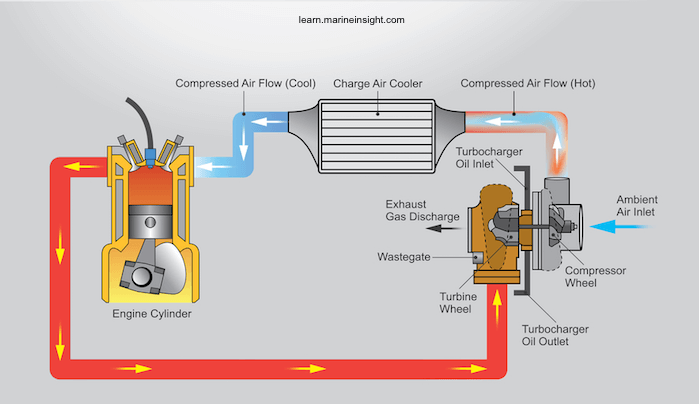
How to Prevent Turbocharger Surging?
The following are ways to prevent turbocharger surging. However, it is to note that some points may vary with the design and construction of the turbocharger.
- Keep the turbocharger intake filter clean.
- Water-wash the turbine and the compressor side of the turbocharger
- Proper maintenance and checks should be done for different turbocharger parts periodically. If there are any issues, turbocharger repair to be done as soon as possible without loading the engine
- Soot blow should be done from time to time in case of economizer or exhaust boiler
Related Read: Do’s and Don’ts for Efficient Boiler Operations On Ships
- Indicator cards to be taken to assess the cylinder and power distribution of individual units
- Ensure the engine auxiliaries and parts which affect the turbocharger are maintained properly
- Efficient maintenance of air cooling system
- Regular cleaning and inspection of economizer
- Regular cleaning and inspection of the exhaust manifold
Design modification to counter surge:
There are few measures and design modifications which can be utilised as anti-surge for reducing the chance of surging. It can be temporarily counteracted by “blowing-off” air from the valve located at the top of the air receiver. However, this will lead to an increase in the exhaust temperatures, and care must be taken not to exceed the limiting values.
Apart from the above anti-surge modification, there are different types of turbocharger available in the market, which experience less surging phenomenon than the conventional turbocharger:
Hybrid Turbocharger: The hybrid turbocharger provides better torque to the compressor turbine from the engine which reduces the risk of turbocharger surging. Read More About Hybrid Turbocharger.
Variable Geometry Turbocharger: VGT experience almost no classic surging as it operates much closer to the surge margin for achieving the highest pressure. Read More About Variable Geometry Turbocharger.
Two-stage turbocharger: Two-stage compressors also have bypasses designed to suppress compressor surging. Read More About Two-Stage Turbocharger
You might also like to read:
- How To Clean Blower and Turbine Sides of a Turbocharger on Ship?
- Hybrid Turbocharger for Marine Engines: Maritime Technology Innovation
- Understanding Turbocharger Bearings and Lubrication On Ships
- 10 Points for Efficient Turbocharger Operation On Ships
- How Variable Geometry Turbocharger for Marine Engines Works?
Disclaimer: The authors’ views expressed in this article do not necessarily reflect the views of Marine Insight. Data and charts, if used, in the article have been sourced from available information and have not been authenticated by any statutory authority. The author and Marine Insight do not claim it to be accurate nor accept any responsibility for the same. The views constitute only the opinions and do not constitute any guidelines or recommendation on any course of action to be followed by the reader.
The article or images cannot be reproduced, copied, shared or used in any form without the permission of the author and Marine Insight.
Do you have info to share with us ? Suggest a correction
Subscribe To Our Newsletters
By subscribing, you agree to our Privacy Policy and may receive occasional deal communications; you can unsubscribe anytime.




its nice explain…………..thanx
Glad you Liked it.
I am not clear about this SURGING concept… Only back flow of exhaust gases and back flow of air into the blower side is known as surging. after a crash stop, their will be no exhaust gases, but the turbocharger continue’s to rotate, but their is no demand of air, it flows back causing a huge sound and damage to turbocharger. This is wt my lecturers explained.but I am not clear about it. How bad weather cause surging, can u explain Al these in detailed form
If surging of turbocharger is occurred, Should the engine be slowed?
Thanks for your good explanation. I need this information very much.
we have a vasa v18 wartsila engine at the power plant it surges when on high load.
is there any cause that would have cause this atfer it has come back from service?
thank you
sounds clear!
thanks.
So in others words we can say that the surge effect is wwhen the air pressure after the compressor is higher than the compressor internally can maintain or am I mistaken?
Why the turbocharger is only surging when it is travelling to critical speed. From the time it shift to higher rpm reaching the critical speed it always surge having hard time to passed up the critical speed rpm? But when the engine is already passed the critical speed rpm there is no more surging, verified all the exh valve, FO injector nozzles and load all okay. During normal speed at sea everything is okay. My main concern here is why it only surhed when it travels to critical speed?
Very well explained..thank you
Thank You for this short and good information.
we have faced Turbocharger failure two times in one DG frequently within two week time abnormal howling sound observed from compressor side. after failure of the turbocharger both turbochargers Compressor impeller vanes and bearings got damaged. During engine running condition all cylinders exhaust gas temperature were normal. one Turbocharger after installation with in one week this accident happened ,so the turbine wheel, nozzle ring and intake air filters are cleaned condition.
If any other reason is there from Engine side or turbocharger, pls give suggestions.
I have the same problem as mr giovan on b&w 6s50mc any body can help
Giovan says:
August 7, 2016 at 1:49 pm
Why the turbocharger is only surging when it is travelling to critical speed. From the time it shift to higher rpm reaching the critical speed it always surge having hard time to passed up the critical speed rpm? But when the engine is already passed the critical speed rpm there is no more surging, verified all the exh valve, FO injector nozzles and load all okay. During normal speed at sea everything is okay. My main concern here is why it only surhed when it travels to critical speed?
@Sohell: At critical speed, the stresses on the main engine are very high. Hence it will have to do more work to overcome those stresses and pass the critical speed. Before reaching the critical speed the engine will will require usual air supply from turbocharger to burn the fuel, however, when critical speed is reached, the engine will try to overcome the additional stresses and also to maintain the given speed. This sudden change in engine behaviour will lead to reduction in air supply from the turbocharger, which leads to surging.
@Soheil: At critical speed, the stresses on the main engine are very high. Hence it will have to do more work to overcome those stresses and pass the critical speed. Before reaching the critical speed the engine will will require usual air supply from turbocharger to burn the fuel, however, when critical speed is reached, the engine will try to overcome the additional stresses and also to maintain the given speed. This sudden change in engine behaviour will lead to reduction in air supply from the turbocharger, which leads to surging.
Hi mr anish i exprianced that when the vessel is loaded this surging hapening.
This time i closed all eng room openings sky light….
And kept all e/r fans in supply.
Instruct to bridge to stay in dead slow to maintain related ships speed.furtunately engine passed critical rpm smoot without t/ch surging.
Tanks for your help.